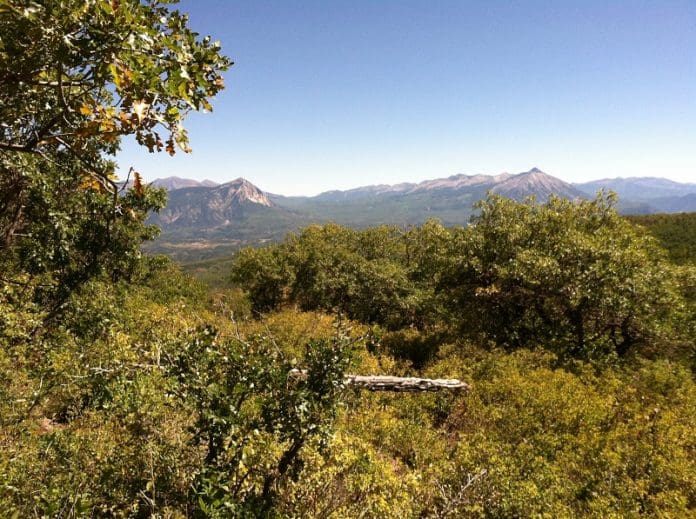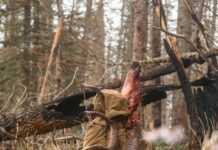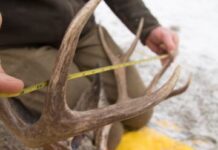Accepting the Challenge of Western Hunting
By Justin Smith, Rokslide Member & Guest Writer
It was the afternoon on the third day of a seven-day hunt. Day one and two proved elk were in the area, but the post rut nature of the beast had them seeking shelter in the dark timber through most of the day. A blanket of snow lightly covered the ground in most of the high country; and the crisp, cool air seemed to cut like a knife in the strong wind gusts.
Small bits of information learned in the first two days were like pieces of a puzzle that were beginning to show a picture. The elk were feeding in the meadows below at night, then retreating to the dark timber in the mountains during the day. The sight of elk traveling at first light, tracks, and a few early bugles in the dark timber were tips that this was the pattern. The elk tracks were easily visible in the light blanket of snow that fell the night before, and confirmed the theory. It was evident that all of the elk were moving the same direction that morning. I walked nearly nine miles that day following tracks and trying to develop a plan for the remainder of the hunt.
I did not want to push into the dark timber this early in the hunt and risk pushing the elk herd out of the area. Taking a less aggressive approach (with still four days ahead of me for hunting), I decided to set up on the edge of the dark timber about a half mile above the meadows below. My hopes were to find the elk staging in the scrub brush on the edges of the dense cover, waiting on nightfall to move to the feeding grounds below. I set up on a high ridge where I could see about 350 yards, facing the “safe cover” with the wind in my favor.
With approximately twenty minutes left of shooting light, I cow called. I was answered by a bugle that sent chills up my spine. I answered his bugle with another cow call, then put my call down. He knew where I was, the question was “would he make it to me before the sun sets?” It wasn’t long and he emerged into an opening. My heart skipped a beat as I watched the magnificent animal look my way. He was not alarmed, and I knew he was looking for the cow that made the lonely sounds just moments ago. Square behind my gun and holding a steady aim, I touched the trigger. The sound from the rifle echoed through the mountains, and a lifelong dream to harvest a bull elk had been fulfilled.
Author’s 5×5 Idaho Self-guided bull elk
Now that, my friends, is where this story ends. The question is…where did it begin?
As a young hunter, I remember looking at images of mountain hunts on the covers of magazines, dreaming of “one day”. Being from a working class family in West Tennessee, a western big game hunt seemed so far out of reach. I started hunting small game when I was very young, and harvested my first whitetail deer when I was eleven years old. After hunting locally for more than twenty-five years in the Mississippi River and Tennessee River Valleys, the call to hunt western big game was more than I could stand.
Looking back on the challenges, mistakes, and experiences; I realize that the biggest thing holding me back was fear. Not fear in the terms of being frightened, but fear of the unknown—fear of being unprepared and fear of failure. Once I made the decision to “go for it” and accepted the challenge, the fear was behind me and my relentless pursuit began. I made it through a couple of hunts where I did not fill my tag, but they were not unsuccessful. I was able to experience western adventure, and learn valuable information each step of the journey.
Part Two: Getting Prepared
There is a wealth of information that a hunter can find these days to prepare them in terms of gear, narrowing down a place to hunt, how to buy a license, etc. My goal with this article is to share with you some of my experiences (good and bad) to help you plan your hunt and make the decision to “go for it” yourself.
Make a Plan
As I’ve noted above, you can research the gear checklist you need and put your pack together. I have found little written about things like: planning the road trip, putting together a group of hunters that get along well and have a mindset that is in sync with your own, maximizing your vacation time, and managing the expenses. These items may be considered “common sense” to veteran western hunters, but paying attention to these details can lead you to an enjoyable experience in the west.
• The Road Trip – The first time that I went to Colorado to hunt elk; I borrowed a trailer, loaded it down, and off we went. Three hunters in a crew cab truck headed west on a twenty-five hour haul. After four trailer-tire blow outs and a flat tire on the truck, it was apparent that I should have put more thought into traveling to and from the drop zone. Since that dreadful run, I put a lot of attention on the quality and maintenance on the trailer hauling our gear and the reliability of the vehicle we’re travelling in. Once I am satisfied that my equipment is worthy of the haul, I still make sure my “roadside assistance” tools are in place (floor jack, spare tires, etc.).Make sure your truck and trailer are ready for the haul. Heavy loads can take their toll on a trailer on a long trip
Another thing to consider is the drive. My group typically drives straight through, only stopping for fuel and food. We agree to NEVER drive sleepy, and riding with three in the truck works for us. Our plan is that the front seat passenger stays awake with the driver while the back seat passenger sleeps. At every fuel stop we rotate like well-trained volleyball players. This works for us. The point is, have a plan. If you need to stop along the way to break the drive up into two days, be in agreement with your fellow hunters that this is the plan. Think it through, avoid arguments on travel plans.
• Pick your Hunting Partners Carefully – From the start of the road trip to the end of the hunt, you are going to be side-by-side with your fellow hunters. Small things that you would normally overlook will drive you crazy by the seventh day (unless you have the patience of Job). Pick hunting partners that have similar interests, similar work ethic, and are as committed to the hunt as you are. If you’re like me, the investment in time and energy is too valuable to have a negative experience because you’re not getting along with your hunting “buds”. Hunting is fun, so put a group together that you can trust and have fun with. When things are not going as planned and tensions start to build, these are the guys (and gals) that have your back.
• Plan your Time and Money – When it comes to time and money, both have limits. A CPA once told me to put my priorities in this order and everything else will fall in place: faith, family, career, hobbies (in my case hunting and fishing). As I write this article, I visualize a working class individual who is on the fence about making the commitment to chase western game. An individual who thinks a western hunt may cost too much, and only has a week or two vacation to get it done. I’ve hunted two different ways with over-the-counter (OTC) tags. The first way is archery hunting public land, and the second way is rifle hunting on non-guided private land. Both can yield success, and with every trip I learn from my mistakes and successes.
As far as your time off, use your weekends/off-days to your advantage. Plan your travel to and from the hunt with efforts to maximize your time actually hunting. I try to give myself at least one day of scouting before the hunt starts. Once the hunt begins, it is a persistent pursuit of gathering information and learning the land to close the gap on the elusive animals. The best you can do is plan your hunt to provide you with the highest odds of success.
Planning a hunt that is in your budget is very important. Brian Call and Aron Snyder really provide some good information on Gritty Bowmen Podcast Episode 183: Our 2016 Hunts, What They Cost & How You Can Do Them. Public land hunts have been my most economical hunts. I have been able to complete OTC archery hunts on public land for less than $1,500.00. This includes the cost of the license, food, fuel, and miscellaneous expenses. Split the cost for common expenses such as food, fuel, and lodging with your hunting buddies. Also, give yourself a little safety margin in your budget. It won’t hurt to return home with a little money left over, but running over budget is never pleasant.
If your budget allows you spend a little more, I have hunted non-guided private land hunts that the total costs ended up approximately $4,600.00. This hunt can offer a chance for game that is less pressured than those on public land while maintaining the satisfaction of getting it done on your own. Huntin’ Fool’s Jeff Warren is a good resource for finding these kinds of opportunities. Fully-guided hunts start to exceed the limits of my finances, so I have really enjoyed these non-guided DIY private-land hunts.
Variations such as the fuel economy of your vehicle, the food you buy, the duration of your hunt, etc. will differ for every hunting group. If you share the common expenses and plan ahead, you can most likely plan a hunt that is in your budget.
Part Three: Getting Physical
Don’t Let Your Physical Condition Determine the Outcome of Your Hunt! Take it from me, I’ve experienced the mountains when I was not in the condition to do so. My first trip to Colorado on an archery OTC elk tag was quite the learning experience. We were camped at about 10,000 feet, and we were hunting downhill to the elk (trying to keep the rising thermals in our favor). My buddy killed an elk the very first morning, but had dropped to about 7,000 feet when he made the shot. I never knew how intense the muscles in my legs and core could burn from a work-out until that day. The pack out was brutal, and I was unprepared. The next day, I dropped off the mountain, legs still burning from the previous day’s pack out, chasing the sounds of bugling elk. Towards the end of the day when I decided to start climbing back to camp, I quickly realized that I had not recovered. Running out of food and water, it took me nearly ten hours to climb back to camp. I was drained physically and mentally. I was literally falling to my knees with every few steps, and pretty much ended my chances of being in the hunt for the next two days.
The next year at the same location, I found myself hesitant to pursue bugling elk. Standing on the steep knolls overlooking the valleys below, the voice in the back of my mind telling me “if you go for it, you won’t be able to climb back out”. That hesitation will not yield success in the mountains, and again I returned home without an elk. I did return home from that trip with a purpose: I would never let my physical condition be the determining factor in whether or not I harvest an animal. In a spot-and-stalk situation, a hunter must be able to let his predacious instincts take control. If there is hesitation in your decision to pursue the game, then chances of success are diminished.
Find something or someone that motivates you to be the best you can be. When I returned home from that second trip, I started searching online for the exercises that would yield the best results for a mountain hunter. I found so much inspiration and advice from publications by Cameron Hanes, Dan Staton, MTN OPS , and so on. Find your motivation, and whip yourself into shape. The quote that hit home for me “Every day that bull gets stronger, and every day I sit on the couch I get weaker. The gap between the two of us is growing”.Train to hunt – Training with a specific purpose of becoming a better hunter will without question make you a better hunter
Remain Patient and Confident throughout the Hunt
In all of the hunting and fishing scenarios that I have experienced, maintaining your confidence is critical to success. There are times that I have remained confident and eaten tag soup, but every time that I begin to lose confidence in the outcome of the hunt, my patience begins to dwindle. When I lose my patience and focus, poor decisions are made.
On an OTC archery hunt, we arrived at camp to find two other groups of hunters had been hunting there for several days prior to our arrival. We began our hunt during what should have been the peak of the elk rut. The woods were silent. Without hearing any bugling, we decided that the pressure from the other hunters had pushed the elk out of the spot we found success in the past. Therefore, we changed our plans. We unsuccessfully spent three days trying to find elk in other places. With only two days left in our hunt, we decided to regroup where we started (where we should have been all along). The next morning we had a nice 5×5 bull on the ground and renewed confidence in our “honey hole”.
J D Emison with an OTC archery bull in Colorado
It turns out the elk were where we thought they would be all along. Hunting pressure may have had them silent, but they were still there. We were able to pull elk into bow range with subtle cow calls like they were on a string, but the bulls never made a sound on their approach. I learned that day that if you don’t remain confident, you’ll end up taking yourself out of the game. If you’re not playing in the game you have no chance of winning.
Can’t stay away from GEAR talk
As mentioned early in this article, there is so much information available to today’s hunters regarding gear. You can research on forums such as Rokslide, videos on YouTube, Podcasts, etc. There are a few mistakes that I made along the way that I can’t help but mention.
• Get boots that fit your feet, your hunting style, and are suitable for the season you will be hunting. Blisters on your heels and ankles will make for a rough time hunting in the mountains (been there). Gorilla tape will cover your blisters, but its best to hunt in good boots that fit your feet and avoid the blisters all together.
• I find that I really rely on my navigation tools. I always have a trusty compass in my pack, but I really like the smartphone GPS apps. I prefer OnXMaps Hunt because it has the normal functions of GPS, but also shows property lines and identifies the property owners. That can prove to be useful information.
• I have found that using the smartphone GPS apps drain the battery quickly. For that reason, a portable charging device is always in my pack. I have used several different brands, but I have settled on Dark Energy’s Poseidon Charger. This device can be used by anyone who needs a portable charger, but is made for hunters and works well.
• Have enough coolers to haul your meat home. I carry a 150-quart cooler for each hunter for elk. From my experience a quartered elk will fill up a 150 quart cooler.
Author at camp and running out of cooler space–a good problem to have!
I had a dream of western hunting, but was hesitant to take the leap. A good friend who had been there several times said “If you want to go there and hunt, then why don’t you just go”. I did not have a worthy response to his question. I made the decision to make it happen, and it changed my life. I now live for these big hunts, train all year for the adventure, and take great pride in getting it done. If you have the desire to hunt the high country of the West, I hope that this article encourages you to make it happen. You only live one life, live it to its fullest.
You can ask Justin questions or discuss this article here



















